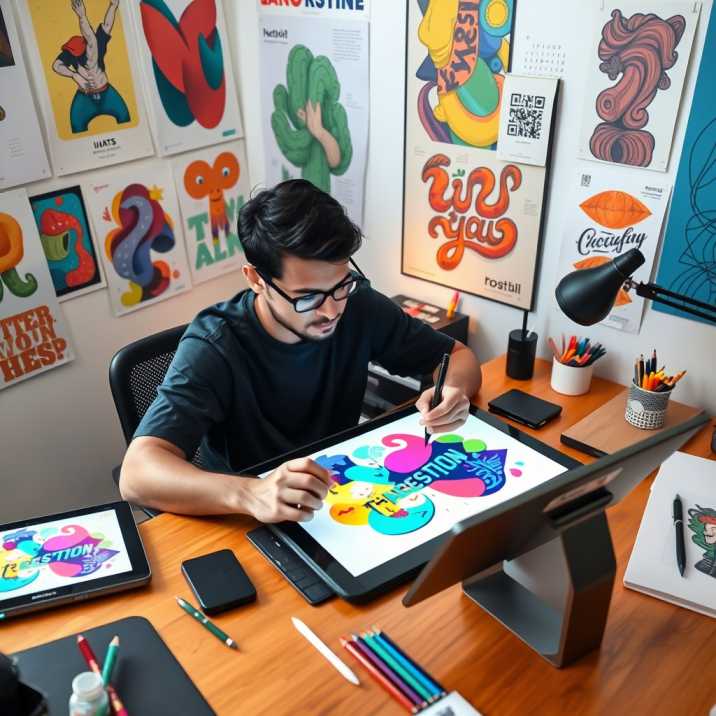
Are you ready to turn your passion for graphic design into a thriving freelancing career? With the right strategies and tools, you can build a successful business while working on creative projects that inspire you. In this guide, we’ll walk you through everything you need to know about graphic design freelancing—from finding clients to mastering essential skills.
Why Choose Graphic Design Freelancing?
Graphic design freelancing offers flexibility, creative freedom, and the potential for lucrative earnings. According to recent data, the global freelance market is expected to grow by 15% annually , with graphic designers being among the most sought-after professionals. Whether you’re looking to supplement your income or go full-time, freelancing opens doors to endless opportunities.
Transitioning from traditional employment to freelancing may seem daunting, but it’s entirely achievable with proper planning. Let’s dive into how you can get started.
Getting Started in Graphic Design Freelancing
1. Build a Strong Portfolio
Your portfolio is your most powerful tool as a freelancer. It showcases your skills, creativity, and versatility. Include:
- Logos, branding materials, and social media designs.
- Mockups of websites or mobile apps.
- Print designs like brochures or posters.
Platforms like Behance and Dribbble are excellent places to host your work. Make sure your portfolio reflects your unique style while targeting your ideal audience.
2. Master Essential Tools
To succeed as a graphic designer, you must be proficient in industry-standard software such as:
- Adobe Photoshop
- Adobe Illustrator
- Canva (for simpler projects)
Additionally, consider learning prototyping tools like Figma if you want to expand into UI/UX design. These skills will make you more competitive in the marketplace.
Finding Clients: Where to Start
3. Leverage Freelance Platforms
Freelance platforms like Upwork and Fiverr are great starting points for beginners. They allow you to connect with clients worldwide and gain valuable experience. However, keep in mind that these platforms often charge service fees.
4. Network Actively
Networking is crucial for long-term success. Join online communities such as Reddit or LinkedIn groups focused on freelancers. This not only builds relationships but also establishes trust within the community.
Moreover, attending virtual conferences or workshops can introduce you to potential collaborators or mentors who might recommend you to their network.
Pricing Your Services Effectively
One common challenge for new freelancers is setting competitive yet profitable rates. Research what other designers charge based on location, expertise, and project complexity. For example:
- Logo design typically ranges from $50 to $500 per project.
- Web design services may cost anywhere between $500 and $5,000 depending on scope.
Consider offering package deals to attract repeat customers. Additionally, always provide clear terms upfront to avoid misunderstandings later.
Pros and Cons of Graphic Design Freelancing
Pros
- Freedom to choose projects that interest you.
- Opportunity to work remotely from home to anywhere in the world is the best desire.
- Ability to scale your income based on effort and demand.
Cons
- Irregular income flow during slow months.
- Managing administrative tasks like invoicing and taxes.
- High competition requires constant skill improvement.
Despite the challenges, many find the rewards outweigh the drawbacks when approached strategically.
Tips for Long-Term Success
- Continuously update your skills by taking courses on platforms like Coursera
- Invest in marketing yourself through social media channels like Instagram or Pinterest.
- Always request feedback from clients to refine your process and improve satisfaction levels.
By implementing these tips, you’ll position yourself as a reliable professional capable of delivering exceptional results consistently.
Common FAQs About Graphic Design Freelancing
- What qualifications do I need to become a graphic design freelancer?
- While formal education helps, a strong portfolio matters more than degrees.
- How much can I earn as a graphic design freelancer?
- Earnings vary widely; beginners may start at $20/hour, while experienced designers earn over $75/hour.
- Is coding necessary for graphic design freelancers?
- Not mandatory, but basic HTML/CSS knowledge enhances web-related projects.
- Which tools are best for beginners?
- Start with free options like Canva before moving to paid software like Adobe Creative Suite.
- How do I handle difficult clients?
- Set boundaries early, communicate clearly, and document agreements in writing.
- Should I specialize in one type of design?
- Specializing increases perceived expertise but diversifying broadens client base.
- How do I manage taxes as a freelancer?
- Use accounting tools like QuickBooks or consult a tax professional familiar with freelancers.
- Can I freelance part-time while employed?
- Yes, many start part-time until they establish steady workflows.
- Do I need a website?
- Absolutely! It acts as your digital resume and central hub for showcasing work.
- How do I stay motivated during slow periods?
- Focus on personal development, networking, or experimenting with new techniques.
Conclusion
Embarking on a graphic design freelancing journey can be both exciting and rewarding. By building a standout portfolio, leveraging freelance platforms, and continuously improving your skills, you’ll create a sustainable career doing what you love. Remember, success doesn’t happen overnight—it takes dedication, persistence, and adaptability.
For further information, Contact us OR Pentheblog .
